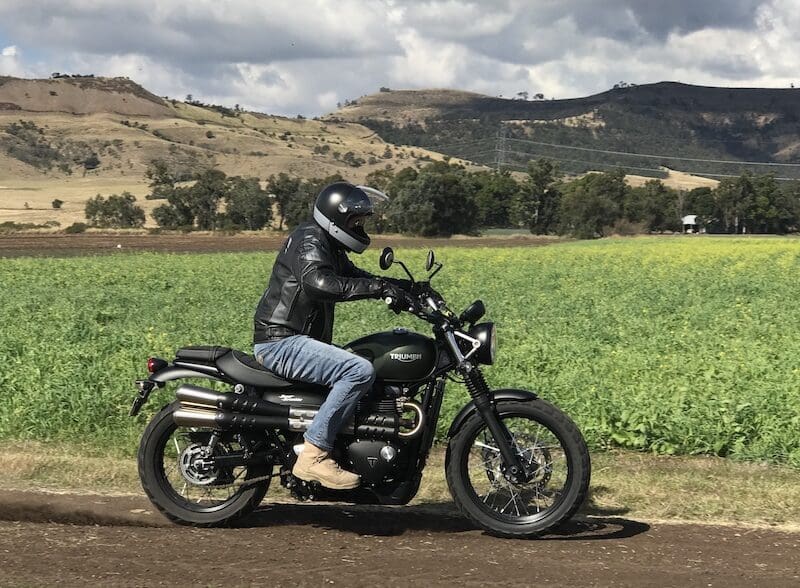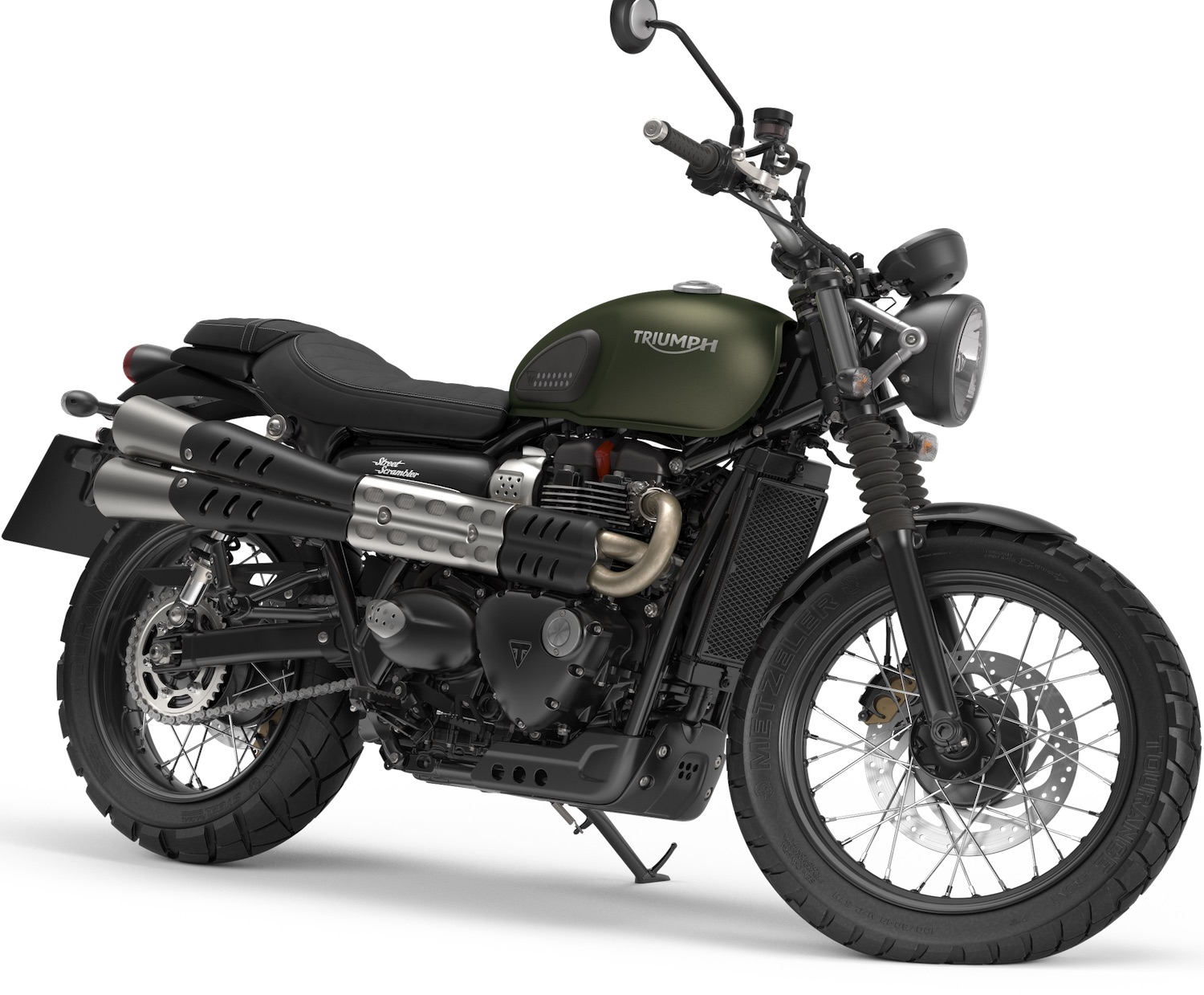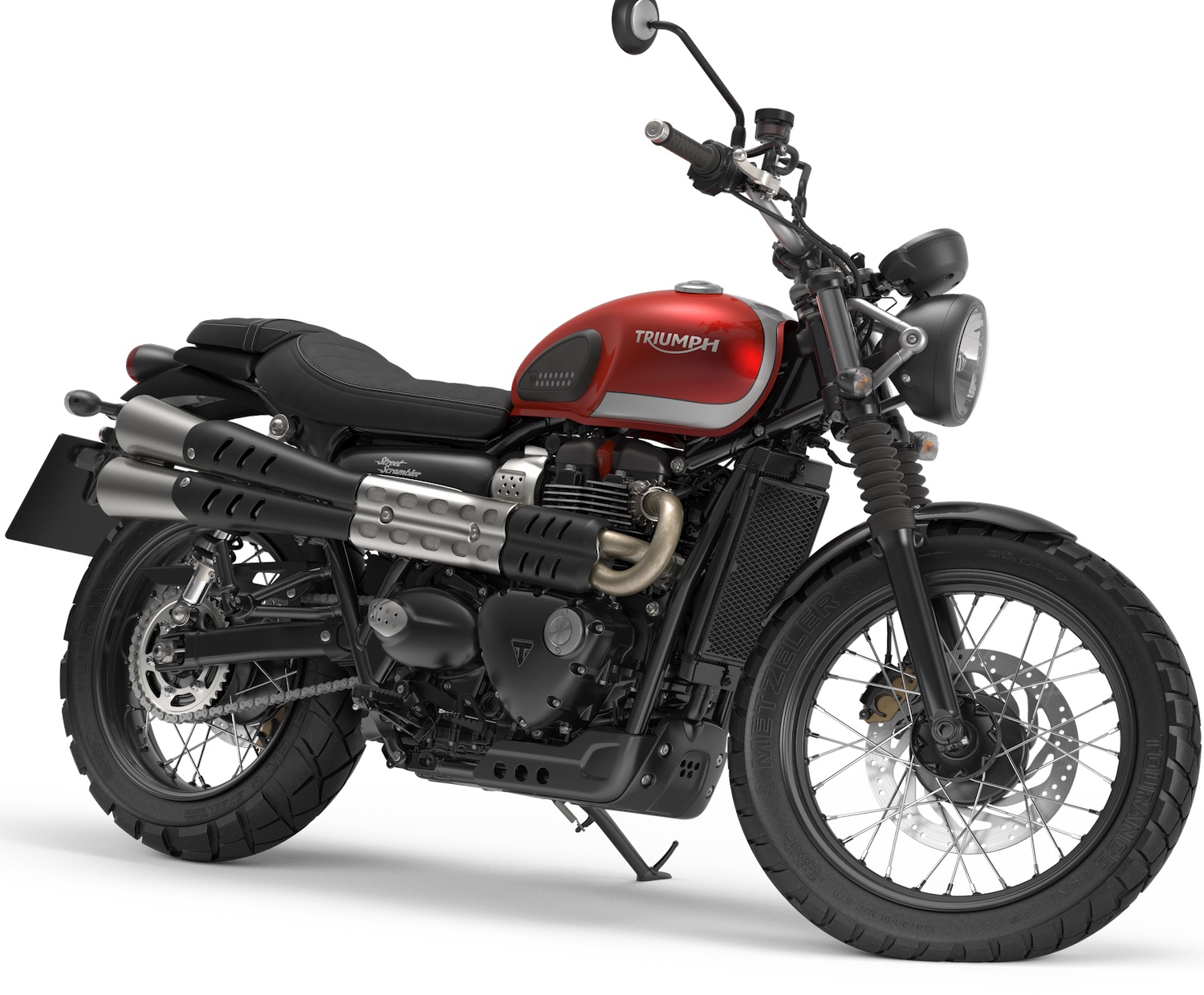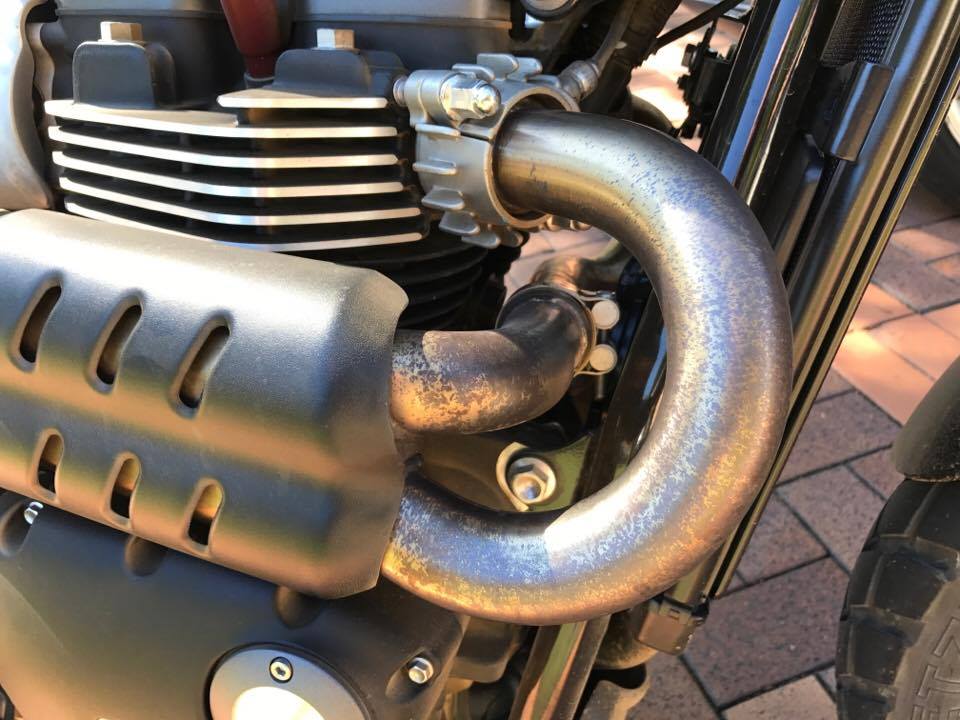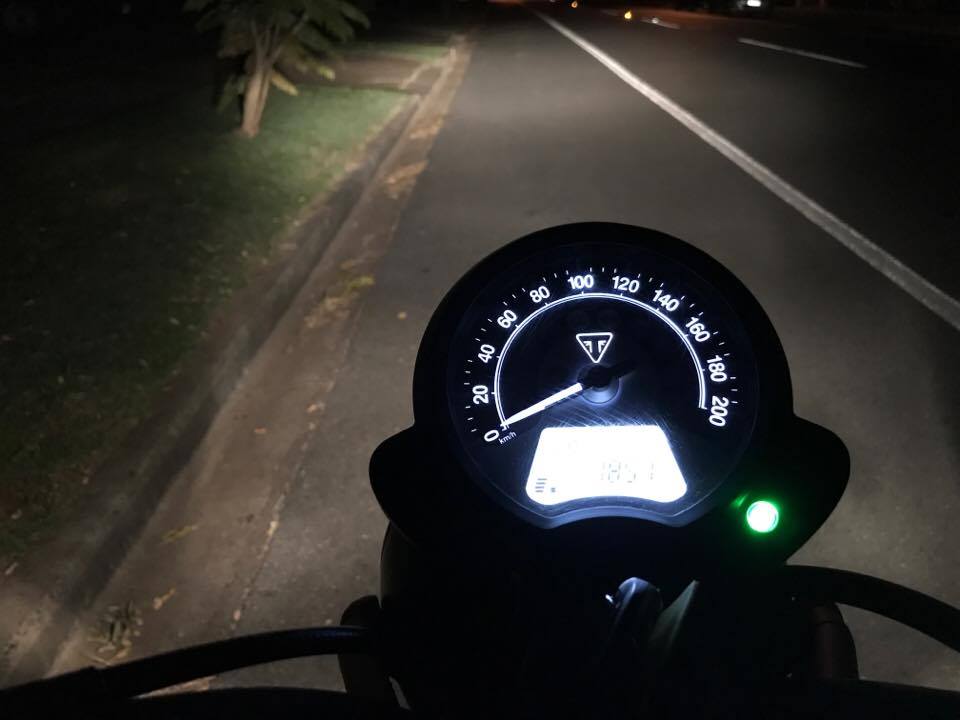The Triumph Street Scrambler sits neatly in the middle of the top three modern scramblers, yet it is in no way a compromise machine.
Compared with the BMW Scrambler and Ducati Scrambler, the Triumph claims the middle ground on price, performance and weight.
Yet there are many things to like about the Street Scrambler that make it perhaps the best balanced bike with benchmark suspension, excellent traction control, a smooth and usable engine, light clutch and precise transmission, and one of the best anti-lock braking systems on dirt roads.
The Street Scrambler costs $15,900 plus on-roads in Jet Black and Khaki Green, and $16,100 plus on-roads for the Korosi Red and Frozen Silver livery which compares with the BMW starting at $19,150 and Ducati from $12,990.
Modern-day scramblers
Before going any further, let’s address the elephant in the room – the term “scrambler”.
Modern-day scramblers are not off-road machines, but all-road bikes that will tackle smooth dirt roads, not tracks.
Think more about Steve McQueen playing on the beach sand at the end of On Any Sunday, rather than leaping the barbed wire in The Great Escape.
That said, each of these bikes, in skilled hands, will tackle some moderate tracks.
We took the Street Scrambler out into the country, along smooth highways, down bumpy country roads, on smooth gravel roads and even some rough single track.
It tackled everything except the single track, but that’s not what this is made for.
Powertrain
When Triumph released its new range of liquid-cooled 900cc and 1200cc Bonnevilles, the Scrambler was initially absent.
While the 1200cc models are great machines, I actually prefer the more user-friendly and well-fuelled 900cc engine.
So it comes as a welcome surprise that Triumph chose the 900cc engine for its Street Scrambler.
That’s not to say they won’t introduce a 1200cc Scrambler down the track (‘scuse the pun).
The 900cc engine has exactly the right balance of power and rideability that you need when negotiating difficult conditions such as slippery gravel roads.
Thanks to a responsive, but not overly sensitive ride-by-wire throttle, the rider always feels in control.
We tried some dirt roads with the traction control on and then switched it off. You can’t change on the fly, but have to stop and select neutral. The control switch is the same toggle button on the left switchgear used to scroll through the instrument information.
In the on position, we were able to make swift progress down some slippery roads without any concerns, even on dual-purpose Tourance tyres.
The traction control actually allows a bit of slip before it gently, not abruptly, cuts engine power and throws out a safety net.
With traction control off, we were able to control power slides nicely thanks to the feel and feedback in the throttle. There was no sudden snatch like you get on the Ducati or bulk low-down torque like the boxer.
There is also a smooth transition from idle to power on the throttle which makes tight, feet-up u-turns easy.
Coupled with a light clutch and precise five-speed transmission, the Scrambler is also a delight to use in heavy traffic.
First gear is a bit tall, but then the gears are spaced out up to fifth which sits comfortably at 3300 revs at highway speeds.
That’s just above peak torque, so overtaking is simply a matter of winding on more throttle without having to changed down cogs. You may only feel the need to reach for an absent sixth gear if riding a European autobahn.
Compared with the old 360-degree crank, the 270-degree Street Scrambler engine feels more refined with a smooth midrange, although a slightly buzzy feel when sitting on the highway for long spells.
At idle the dual brushed-stainless steel exhaust purrs like a kitten, but above 3000 revs it develops a delightful big-cat growl that is entertaining without becoming annoying to the rider or other road users.
However, the high pipe throws more hot air on your right leg than the older model and, together with the increased engine heat, could be an issue in summer traffic jams.
One of the biggest surprises about the powertrain was its economy.
Despite some heavy fisted throttle on test, the bike returned fuel economy of 3.8L/100km which exactly matches their claimed figure.
Around town, I achieved a quite remarkable 3.4L/100km. Even with a smaller 12-litre tank, range is still over 300km.
The Street Scrambler not only goes well, but stops strongly with a single 310mm disc up front.
Its ABS is non-intrusive and we have never stopped so quickly and safely on the dirt.
However, it would be nice if there was a “dirt” option to switch off the ABS on the rear and leave it on up front as is available on some BMW GS models.
Styling
The three main scramblers are all quite different in styling, yet have a mixture of traditional and modern design components.
It’s subjective which has the best styling, but I believe the new Street Scrambler looks a bit plasticky compared with its predecessor.
And, unlike the other models in the new Bonneville range, the instruments, exhaust, engine and tail look a bit cheap.
The header pipes and some of the engine embellishments are also looking a bit tired already after only 3000km on the odometer.
However, the switchgear is good quality, the instruments have a comprehensive range of information available, the footpegs have removable rubber inserts for riding in the dirt (and through water) and the two-piece seat has a nice suede-look covering.
After riding down some dusty roads, the seat looked a mess and we were concerned it would retain the dust. However, a quick rinse under the tap restored its condition.
That seat is also one of the most comfortable Triumph has yet produced.
It has the added attraction of quickly being able to swap the separate pillion seat for an optional luggage rack. In Queensland, you can also remove the pillion pegs and register it as a solo bike and halve your annual rego fee.
At night, the instruments actually look quite good with a clear, pale blue light that seems to match the good spread of light from the headlights.
Underneath, there is a plastic bash plate which protects the frame from stone chips which is fine for dirt-road scrambling. If you really want to go off-road, there is an aluminium plate available.
Handling
Despite claiming the middle ground in most aspects, the Street Scrambler handles much better than the BMW or Ducati scramblers which are both firmer and harsher.
Suspension on the Street Scrambler is perfectly set up for my 75kg frame.
Forks and twin shocks have a slightly plush initial hit that irons out corrugations and keeps the wheels on the ground to prevent fork chatter or loss of rear wheel traction under acceleration or braking.
But the springs are also firm enough to avoid bottoming out on big hits or two up.
Despite the 19-inch front wheel, this bike turns in quite quickly, although not as quick as the Ducati.
It certainly feels much more alive, lithe and flickable than the old Triumph Scrambler. That’s probably because it is 24kg lighter than the old model.
It also helps that the Street Scrambler has a high bend in the wide bars which gives you precise control over the bike for tight turns and quick steering manoeuvres.
It initially felt too high and I thought it would be uncomfortable, but that is not the case. When I went back to my old Scrambler, I felt the bars were too low and narrow.
The new Street Scrambler has slightly more clearance than the old Triumph Scrambler, but it still retains the brake caliper on the bottom of the rear disc which limits clearance in a rut.

If you do some single track, take it slow and you can make steady progress.
Some riders might like the fact that it has a 20mm lower seat than the previous model and is as low as the Ducati. At 790mm, it will suit many female and shorter riders.
Conclusion
The choice between the top three scramblers is now even harder with the addition of the Street Scrambler.
It might sit neatly between the BMW and Ducati on paper, but in real-world performance there is much to recommend in the Triumph.
Triumph Street Scrambler
- Price: $15,900 plus on-roads (Jet Black, Khaki Green), $16,100 (Korosi Red, Frozen Silver)
- Engine: Liquid cooled, 8-valve, SOHC, 270° crank, 900cc parallel twin
- Bore x Stroke: 84.6 x 80mm
- Compression: 10.55:1
- Power: 40.5kW @ 6000rpm
- Torque: 80Nm @ 2850rpm
- Transmission: wet, multi-plate assist clutch, 5-speed, chain drive, clutch assist
- Chassis: Tubular steel cradle frame, twin steel swingarm
- Wheels: 19 x 2.5in; 17 x 4.25in steel spoked
- Tyres: 100/90-19; 150/70 R17
- Suspension: KYB 41mm forks, 120 mm travel; KYB twin shocks with adjustable preload, 120mm travel
- Brakes: 310mm disc, Nissin 2-piston floating caliper; 255 mm disc, Nissin 2-piston floating caliper; ABS
- Width: 831mm
- Seat: 790mm
- Wheelbase: 1446mm
- Rake/trail: 25.6º/109mm
- Dry weight: 206kg
- Tank: 12 litres
- Economy: 3.8l/100km (claimed and tested)


